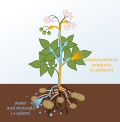Translocation (botany)
Translocation in vascular plants means the movement of organic molecules and some mineral ions. Movement of water from the soil to the leaves occurs in xylem vessels as the result of Transpiration. Transpiration, the evaporation of water from leaves, causes a pull on the water column due to the forces of cohesion between water molecules formed due to hydrogen bonds which causes the water to move upwards. Organic materials, mainly produced in the leaves, are moved around the plant in the living cells of the phloem by a process called translocation.
Unlike xylem (which is composed of dead cells), the phloem is composed of still-living cells that transport sap. Sap is a water-based solution, rich in sugars made by the photosynthesis. These sugars are transported to non-photosynthetic parts of the plant, such as the roots, or into storage structures, such as tubers or bulbs.
The 'pressure flow' hypothesis was proposed by Ernst Münch in 1930 to explain the mechanism of phloem translocation.[1] Leaves photosynthesize, making sugars. Water moves into the sugar-laden sieve-tube cells with sugar by osmosis. This creating pressure that pushes the sap down the sieve tube. When the sugar reaches cells that need it, the cells actively transport sugars out of the sieve-tube elements.
During the plant's growth period, usually during the spring, storage organs such as the roots are sugar sources, and the plant's many growing areas are sugar sinks. The movement in phloem is multi-directional, whereas, in xylem cells, it is one-directional (upwards). Other molecules like amino acids, hormones, and even messenger RNAs are also transported in the phloem through sieve tube elements.[2]
Translocation (botany) Media
Cross-section of a flax plant stem: Template:Ordered list*
References
- ↑ Münch E. 1930. Die Stoffbewegunen in der Pflanze. Jena: Gustav Fischer, 234.
- ↑ Turgeon, Robert & Wolf, Shmuel 2009 (2009). "Phloem transport: cellular pathways and molecular trafficking". Annual Review of Plant Biology. 60: 207–221. doi:10.1146/annurev.arplant.043008.092045. PMID 19025382.



